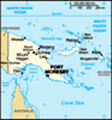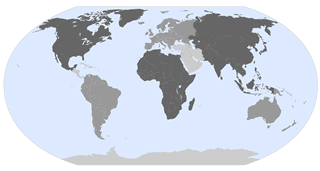Advertisement
Published: February 25th 2008
Upon leaving Australia we started retracing the path of the Navy in World War II. We crossed the Coral and Solomon Seas to reach Papua New Guinea. This enormous ocean which is sometimes referred to as the “Great Blue” seems to stretch to the ends of the earth. One of the passengers remarked that if this ship had a glass bottom, we would be able to see most of the Japanese Naval Fleet lying on the ocean floor. The battle of the Pacific was one of the epic conflicts in naval history. In 2005 when we cruised much of this same territory, there was a guest lecturer who was a naval historian, and there were many WWII vets cruising as passengers. This year, about the only vets on board are those who enlisted at a very young age and now most of them are reaching their advanced years. We are quickly losing the War Generation. It was 63 years ago that victory was declared and hostilities ceased. Now when we cruise these waters we search for whale spouts rather than submarine periscopes.
Since it takes a lot of cruising to cross this vast expanse of water, the ship arranged to
have many noted guest speakers to fill the days at sea. Terry Waite, the Englishman held hostage in Beirut for 1763 days, much of the time in solitary confinement and chained to a wall, gave some very inspirational lectures dealing with how he was able to survive physically and emotionally in such torturous conditions. There were talks on marine navigation, Asian history and art, New Guinea culture and oceanography. We were interviewed by Ellen Uzelac, a Cruise Critic correspondent and travel writer. She was interested in hearing our perceptions on the recent surge in the popularity of world cruising. We think that it is a result of several factors. One is that many people in this socio-economic group are quite well traveled, having seen most of the world in depth. Now they would like to have a voyage of rediscovery and a convenient way to travel around the world in style. It seems that many people are trying to avoid airports and airplanes as much as possible and this affords a way of travel without the inconvenience of flying. Also the advent of the internet allows guests the freedom to travel for long periods of time and still feel connected
to their families, homes and businesses. Online bill paying is a great invention.
We spent a day in Madang, Papua New Guinea. It is such a beautiful yet primitive place that it is always interesting to visit. Since so few ships call here, it is a big event when we arrive. It seems like the whole populace came out to greet us as we passed inside the reef. Since it was Sunday, the few commercial outlets in town were closed. But outside the port gate there was a craft market set up. It was in reality just local folks displaying their homemade wares on blankets placed on the ground. In addition to the usual array of beads and baskets, there were many items whose main focus was on virility and fertility. The penis sheaths and gourds seemed to be the most popular souvenir purchases. Most of the peoples on this remote island have only recently emerged from the Stone-Age. Up in the highlands, there are still reports of cannibalism. Most of the people chew betel nut, which gives the user a slight high and very distinctive red lips, teeth and gums. We noticed that even young children are betel
nut devotees. It is called PNG lipstick. I was recently reading an article about PNG and how their society is basically ruled by superstition. The rites of passage are centuries old traditions. Scarring of girl’s backs and the ritualistic circumcision of teenage boys are still practiced today. Most of the wooden carvings at the craft market depicted these ceremonies in vivid detail. All of the purchases were taken by the ship’s staff, labeled, put in plastic bags and fumigated before being allowed into the guests’ stateroom.
Some of our friends went on a snorkeling excursion but didn’t see much in the way of sea life or WWII wrecks. Sherry asked her guide if there were crocodiles in PNG and was told no. We later told her we had read that in fact they have very large crocs growing to 25 feet in length. We had previously taken that same excursion but were more fortunate in seeing a wide array of interesting things. When cruising out to the diving area, we passed many small homes whose outhouses are thatched affairs built out over the water.
En route to the Northern Mariana Islands we crossed the equator back into the
Northern Hemisphere. There was a country fair where each department sets up a booth with games of chance and skill. Kevin got tangled up with the bar staff at their football scrimmage booth and came away with a bloody shin One night before dinner we were sitting on our balcony when we saw the biggest, brightest falling star ever. It looked like it crossed directly in front of the ship. We called the bridge to ask if they had seen it and they confirmed the sighting of the meteor. We later read in the SF Chronicle newspaper that this same meteor was seen disintegrating over Oregon. Watching this bright fireball streak across the Pacific Ocean sky was truly an amazing celestial experience.
Next up was the small island of Saipan, which has U.S. Commonwealth status and whose residents are U.S. citizens. As we found, this status comes at a high price. We were several hours late arriving in Saipan due to high seas, so an already short stay was made shorter. We were escorted to our berth by a small police boat carrying a man waving a machine gun. Due to security it took two hours to off load
all the passengers, thus we actually ended up with 45 minutes on dry land. It was enough time to take the shuttle bus to town and back without getting off. I had wanted to mail some packages and letters but again due to security nothing can be mailed if it weighs over one ounce without the contents being inspected. Even though it was the middle of the afternoon, the post office was closed and the officials would not permit packages to be taken off the ship by the port agent. The returning shuttle buses weren’t allowed to come inside the gate, so all of the passengers had to get off the buses, be checked with a metal wand and then walk from the gate to the gangway. It was very difficult for some of our elderly and handicapped guests. The Captain later complained about the rigid security rules. The authorities required that the ship depart the port before sunset, thus shortening our stay even further. I’m sure that the local merchants were as disappointed with our brief visit as were we.
That night we had a birthday party for Dr Tinkle who turned 98 years old. He is almost
like the ship’s mascot as he is loved by guests and staff alike. Before each cruise he learns 50 new songs on the piano and he plays them every morning in the atrium of the ship. He is from Sioux City where we visited him several years ago. Last year he left the ship in Oman with a broken hip. At that time we weren’t sure if he would ever be cruising again. So this party was a double celebration—his birthday and his return to the cruising life. He enjoys dressing in costume during the cruise. So all us wore hats and Asian clothes in Tink’s honor. We had a lively evening toasting this gentleman’s joie de vivre.
Our morning cruising just off the coast Iwo Jima turned out to be one of the highlights of the cruise thus far. This legendary island which was the setting for one of the most famed photos of WWII, just looks like a rock in the ocean. To think what it cost both the U.S. and Japan in terms of life and equipment is astounding especially when you see the place. There were over 27,000 soldiers killed during the 35 day Battle
of Iwo Jima. The picture taken by Joe Rosenthal of the raising of the flag on Mt Suribachi is perhaps the iconic image of the war and probably the most reproduced picture ever. Two recent movies by Clint Eastwood have educated post-war generations about the monumental battle for this strategic bit of soil. “Flags of our Fathers” presents the war from an American perspective while “Letters from Iwo Jima” shows what a disastrous trap the Japanese had gotten themselves into. As we approached the volcanic island, we could see steam rising from fissures on the side of the mountain. The beaches are still littered with rusting landing craft and other war debris. The commemoration program arranged by the staff was so touching that it moved many to tears. Military veterans assembled at the bow of the ship. The American flag was raised and a short speech was made honoring those who served their country and memorializing those who perished in the war. Then “Taps” was played and Kevin lowered the flag in salute. The program ended with a minute of silence and Kate Smith’s rendition of “God Bless America.” While this was going on, the ship was surrounded by a
pod of whales spouting and breaching. Even though the island has been returned to Japanese control and the name changed to Iwo To, this speck of land in the middle of the ocean will always remain a symbol of the courage and bravery and heroism of the American fighting forces.
Advertisement
Tot: 0.054s; Tpl: 0.011s; cc: 12; qc: 29; dbt: 0.0259s; 1; m:domysql w:travelblog (10.17.0.13); sld: 1;
; mem: 1.1mb












